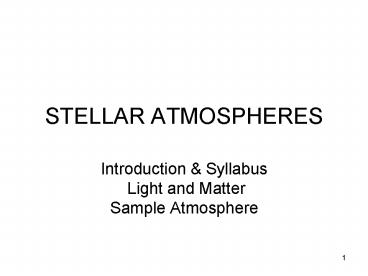STELLAR ATMOSPHERES PowerPoint PPT Presentation
Title: STELLAR ATMOSPHERES
1
STELLAR ATMOSPHERES
- Introduction Syllabus Light and MatterSample
Atmosphere
2
Introductions and Syllabus
- Available on-line at class web sitehttp//www.cha
ra.gsu.edu/gies/ASTR8000/ - TextsGray Stellar Photospheres (older editions
OK)Mihalas Stellar Atmospheres (out of
print)Mihalas2 Radiation Hydro (21)Collins
Fundamentals available on-line
athttp//ads.harvard.edu/books/1989fsa..book/Boh
m-Vitense Stellar Astrophysics Vol. 2
3
Rutten (Utrecht) Notes On-line
- Radiative Transfer in Stellar Atmosphereshttp//w
ww.astro.uu.nl/rutten/Lecture_notes.html - Good set of notes that emphasizes the physical
aspects (versus the observational emphasis in
Gray) - We will use these notes frequently
4
Two Courses
- Astr 8000 Stellar Atmospheresbasics, building
model atmospheres, resulting continuous spectra,
use to determine properties of starsGray
Chapters 1 10 - Astr 8600 Stellar Spectroscopydetailed look at
the line spectra of stars (bound-bound
transitions), applications Gray Chapters 11 18
5
(No Transcript)
6
Introduction
- Understand stars from spectra formed in outer
1000 km of radius - Use laws of physics to develop a layer by layer
description of T temperatureP pressure andn
densitythat leads to spectra consistent with
observations
7
First Approximation
- Stellar spectra are similar to a Planck black
body function characterized by T - Actually assign an effective temperature to stars
such that the integrated energy flux from the
star that from a Planck curve - How good is this approximation? Depends on the
type of star
8
(No Transcript)
9
(No Transcript)
10
(No Transcript)
11
Two Parts to the Problem
Radiation field as a function of frequency and
depth to make sure energy flow is conserved
Physical description of gas with depth example,
T T(t)
12
Parameters
- Teff Effective temperature defined by
integrated luminosity and radius (K) - log g logarithm (base 10) of the surface
gravitational acceleration (c.g.s.) - Chemical abundance of the gas
- Turbulence of the gas
- Magnetism, surface features, extended
atmospheres, and other complicationsAll
potentially derivable from spectra
13
Key Example Robert Kurucz and ATLAS
- Kurucz, R. L. 1979, ApJS, 40, 1(http//kurucz.har
vard.edu/) - Plane parallel, LTE, line-blanketed models
- Current version ATLAS12 runs in Linux
- Units c.g.s. and logarithms for most
- Example Sun
14
geometric depth
optical depth
density
682 km
15
30000 10000 6000 4286
3333 Å
16
(No Transcript)
17
Comparison with Vega (A0 V) Flux
18
Comparison with Vega (A0 V) Lines

